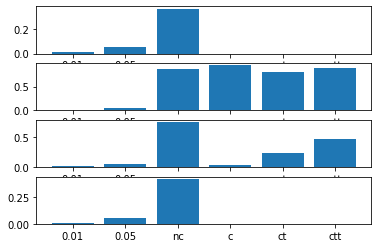
Kurtosis of the normal distribution is 3.0.This property makes Kurtosis largely ignorant about the values lying toward the center of the distribution, and it makes Kurtosis sensitive toward values lying on the distribution’s tails. the ones lying on the two tails of the distribution are greatly emphasized by the 4th power. Conversely, larger values of (y_i-µ), i.e. In other words, values in Y that lie near the center of the distribution are de-emphasized. Because of the 4th power, smaller values of centralized values (y_i-µ) in the above equation are greatly de-emphasized. Kurtosis is sensitive to departures from normality on the tails.Because it is the fourth moment, Kurtosis is always positive.Just like Skewness, Kurtosis is a moment based measure and, it is a central, standardized moment.For the sample, we cheat a little by assuming that the random variable is uniformly distributed, so the probability of each y_i in the sample is 1/n and the third, central, sample moment becomes 1/n times a simple summation over all (y_i -y_bar)³.įormula for population Kurtosis (Image by Author ) Kurtosis has the following properties: In practice, we can estimate the skewness in the population by calculating skewness for a sample. Certain ratio based distributions - most famously the Cauchy distribution - have an undefined skewness as they have an undefined mean µ.While a symmetric distribution will have a zero skewness, a distribution having zero skewness is not necessarily symmetric.Skewness of the normal distribution is zero.So pairs of (y_i- µ) will cancel out, yielding a total skewness of zero. Since the distribution is symmetric around the mean, both y_i values will have the same probability. This is because, for each y_i that is greater than the mean µ, there will be a corresponding y_i smaller than mean µ by the same amount. Because it is the third moment, a probability distribution that is perfectly symmetric around the mean will have zero skewness.Skewness is a standardized moment, as its value is standardized by dividing it by (a power of) the standard deviation.Skewness is a central moment, because the random variable’s value is centralized by subtracting it from the mean.Skewness is a moment based measure (specifically, it’s the third moment), since it uses the expected value of the third power of a random variable.

If the residual errors are not normally distributed, the F-test cannot be reliably used to compare the goodness-of-fit of two competing regression models.įormula for population skewness (Image by Author ) Finally, certain goodness-of-fit techniques such as the F-test for regression analysis assume that the residual errors of the competing regression models are all normally distributed.Best Linear Unbiased Estimator for the model as long as E(ϵ)=0, and all other requirements of OLSR are satisfied. If the residual errors ϵ are not normally distributed, one cannot reliably calculate confidence intervals for the model’s forecasts using the t-distribution, especially for small sample sizes (n ≤ 20).īear in mind that even if the errors are not normally distributed, the OLS estimator is still the BLUE i.e.


I’ll give below three such situations where normality rears its head: Several statistical techniques and models assume that the underlying data is normally distributed.


 0 kommentar(er)
0 kommentar(er)
